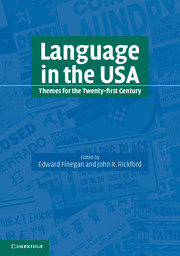Book contents
- Frontmatter
- Contents
- List of figures
- List of tables
- List of contributors
- Acknowledgments
- Foreword
- Editors' preface
- Part 1 American English
- Part 2 Other language varieties
- 7 Multilingualism and non-English mother tongues
- 8 Creole languages: forging new identities
- 9 Native American languages
- 10 Spanish in the Northeast
- 11 Spanish in the Southwest
- 12 American Sign Language
- 13 Asian American voices: language in the Asian American community
- 14 Linguistic diversity and English language acquisition
- Part 3 The sociolinguistic situation
- Index
12 - American Sign Language
Published online by Cambridge University Press: 05 June 2012
- Frontmatter
- Contents
- List of figures
- List of tables
- List of contributors
- Acknowledgments
- Foreword
- Editors' preface
- Part 1 American English
- Part 2 Other language varieties
- 7 Multilingualism and non-English mother tongues
- 8 Creole languages: forging new identities
- 9 Native American languages
- 10 Spanish in the Northeast
- 11 Spanish in the Southwest
- 12 American Sign Language
- 13 Asian American voices: language in the Asian American community
- 14 Linguistic diversity and English language acquisition
- Part 3 The sociolinguistic situation
- Index
Summary
Editors' introduction
Possibly no aspect of language use is more misunderstood than sign language. Probably, too, not many readers will know that American Sign Language – ASL, as it's commonly called – is used in the USA by at least half a million people and perhaps by as many as two million. Among its users are hearing members and deaf members of the American Deaf community. In this chapter, Ceil Lucas and Clayton Valli combine their perspectives to present a description of ASL and its use; many readers will be surprised at how much about ASL and sign languages more generally you have misunderstood. You may also be surprised at how much you know already.
American Sign Language is an autonomous linguistic system whose elements are visual rather than aural. It is a fully formed language, fundamentally like all other languages but differing from most of them in the vehicle used for expression. ASL is not dependent on American English (or on any other language); instead, it has its own system of signs. Some signs are iconic (an iconic sign is one that mimics or directly reflects the referent or meaning) but most signs are arbitrary. In spoken language, too, most signs (in this case, spoken words) are arbitrary, with little or no direct or inherent reference to what they signify.
Like US varieties of English and Spanish, ASL varies geographically (it has dialects) and across social groups.
- Type
- Chapter
- Information
- Language in the USAThemes for the Twenty-first Century, pp. 230 - 244Publisher: Cambridge University PressPrint publication year: 2004
- 3
- Cited by

